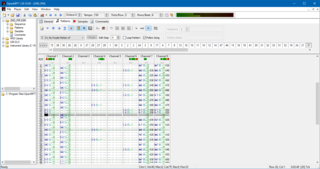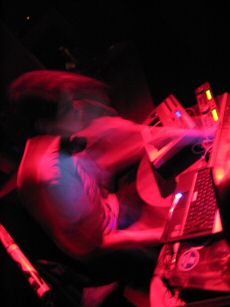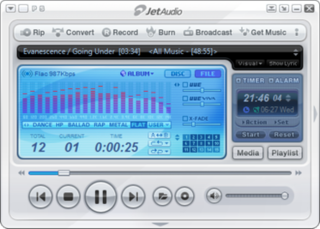
A disc jockey, more commonly abbreviated as DJ, is a person who plays recorded music for an audience. Types of DJs include radio DJs, club DJs, mobile DJs, and turntablists. Originally, the "disc" in "disc jockey" referred to shellac and later vinyl records, but nowadays DJ is used as an all-encompassing term to also describe persons who mix music from other recording media such as cassettes, CDs or digital audio files on a CDJ, controller, or even a laptop. DJs may adopt the title "DJ" in front of their real names, adopted pseudonyms, or stage names.

MP3 is a coding format for digital audio developed largely by the Fraunhofer Society in Germany under the lead of Karlheinz Brandenburg, with support from other digital scientists in other countries. Originally defined as the third audio format of the MPEG-1 standard, it was retained and further extended — defining additional bit-rates and support for more audio channels — as the third audio format of the subsequent MPEG-2 standard. A third version, known as MPEG-2.5 — extended to better support lower bit rates — is commonly implemented, but is not a recognized standard.

A sound card is an internal expansion card that provides input and output of audio signals to and from a computer under the control of computer programs. The term sound card is also applied to external audio interfaces used for professional audio applications.

Digital music technology encompasses digital instruments, computers, electronic effects units, software, or digital audio equipment by a performer, composer, sound engineer, DJ, or record producer to produce, perform or record music. The term refers to electronic devices, instruments, computer hardware, and software used in performance, playback, recording, composition, mixing, analysis, and editing of music.

A music tracker is a type of music sequencer software for creating music. The music is represented as discrete musical notes positioned in several channels at chronological positions on a vertical timeline. A music tracker's user interface is traditionally number based. Notes, parameter changes, effects and other commands are entered with the keyboard into a grid of fixed time slots as codes consisting of letters, numbers and hexadecimal digits. Separate patterns have independent timelines; a complete song consists of a master list of repeated patterns.
Granular synthesis is a sound synthesis method that operates on the microsound time scale.

Scratching, sometimes referred to as scrubbing, is a DJ and turntablist technique of moving a vinyl record back and forth on a turntable to produce percussive or rhythmic sounds. A crossfader on a DJ mixer may be used to fade between two records simultaneously.

Multitrack recording (MTR), also known as multitracking, is a method of sound recording developed in 1955 that allows for the separate recording of multiple sound sources or of sound sources recorded at different times to create a cohesive whole. Multitracking became possible in the mid-1950s when the idea of simultaneously recording different audio channels to separate discrete "tracks" on the same reel-to-reel tape was developed. A "track" was simply a different channel recorded to its own discrete area on the tape whereby their relative sequence of recorded events would be preserved, and playback would be simultaneous or synchronized.

A sampler is an electronic musical instrument that records and plays back samples. Samples may comprise elements such as rhythm, melody, speech, sound effects or longer portions of music.
Video game music (VGM) is the soundtrack that accompanies video games. Early video game music was once limited to sounds of early sound chips, such as programmable sound generators (PSG) or FM synthesis chips. These limitations have led to the style of music known as chiptune, which became the sound of the first video games.

A digital audio workstation is an electronic device or application software used for recording, editing and producing audio files. DAWs come in a wide variety of configurations from a single software program on a laptop, to an integrated stand-alone unit, all the way to a highly complex configuration of numerous components controlled by a central computer. Regardless of configuration, modern DAWs have a central interface that allows the user to alter and mix multiple recordings and tracks into a final produced piece.
Programming is a form of music production and performance using electronic devices and computer software, such as sequencers and workstations or hardware synthesizers, sampler and sequencers, to generate sounds of musical instruments. These musical sounds are created through the use of music coding languages. There are many music coding languages of varying complexity. Music programming is also frequently used in modern pop and rock music from various regions of the world, and sometimes in jazz and contemporary classical music. It gained popularity in the 1950s and has been emerging ever since.

Timothy "Tim" George Hodgkinson is an English experimental music composer and performer, principally on reeds, lap steel guitar, and keyboards. He first became known as one of the core members of the British avant-rock group Henry Cow, which he formed with Fred Frith in 1968. After the demise of Henry Cow, he participated in numerous bands and projects, eventually concentrating on composing contemporary music and performing as an improviser.

Live PA is the act of performing live electronic music in settings typically associated with DJing, such as nightclubs, raves, and more recently dance music festivals.

A dictation machine is a sound recording device most commonly used to record speech for playback or to be typed into print. It includes digital voice recorders and tape recorder.
Ken Hyder is a Scottish jazz fusion drummer and percussionist born in Dundee, Scotland, perhaps best known for combining folk, ethnic and Celtic music with jazz.

Logic Studio is a discontinued professional music production suite by Apple Inc. The first version of Logic Studio was unveiled on September 12, 2007. It claims to be the largest collection of modeled instruments, sampler instruments, effect plug-ins, and audio loops ever put in a single application.
K-Space are a British-Siberian experimental electroacoustic improvisation music ensemble comprising Scottish percussionist Ken Hyder, English multi-instrumentalist Tim Hodgkinson, and Siberian percussionist and throat singer Gendos Chamzyryn. The trio was formed in Tuva, Siberia in 1996. They have played in concerts in Asia and Europe, and released four CDs, including Infinity (2008), which was a new type of CD that is different every time it is played.

Shamanic Music is ritualistic music used in religious and spiritual ceremonies associated with the practice of shamanism. Shamanic music makes use of various means of producing music, with an emphasis on voice and rhythm. It can vary based on cultural, geographic, and religious influences.

JetAudio is a shareware media player application for Microsoft Windows and Android released in 1997, that offers playback options for a wide range of multimedia file formats.













